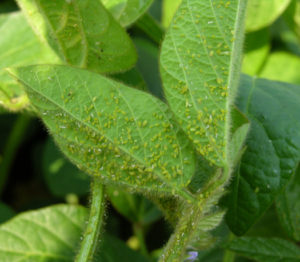First flower open on soybeans means that they have reached the R1 stage. From this stage until the start of R6, where the pods on the top few nodes of the plant are filled with a swollen seed, soybean aphid thresholds kick in.
in.
A few fields were colonized earlier this spring but for the most part those populations have remained low, with the exception of one field in Perth county being sprayed in the next few days. Moisture helps entomopathogens develop that help to control the aphids but they do better when temperatures are a little warmer and the canopy is closed. These moderate temperatures can be ideal for aphid development so it is important to start keeping an eye on fields. Even fields treated with neonicotinoid seed treatments will need to be scouted, since the insecticide will no longer be in the plants at levels that can control the aphids.
Natural enemies play a huge role in keeping aphids below threshold. But sometimes the aphids reproduce quicker than the enemies can keep up and a spray is necessary. It is important to ensure that aphids are increasing above thresholds before a foliar insecticide is applied, since the insecticides tend to do a better job at knocking down the natural enemies for a longer period of time than the aphids, giving the aphids the advantage to re-surge.
Ontario has developed a Dynamic Action Threshold for soybean aphids that not only considers the number of aphids per plant but also the abundance of natural enemies, knowing how many aphids are eaten per natural enemy. This is all incorporated into the free Aphid Advisor app. It helps you decide if there are enough natural enemies to keep up with the aphids or if a spray is needed.
Registered foliar insecticides are listed in the OMAFRA Field Crop Protection Guide. With soybeans in flower, pollinators may be present in the field. Time insecticide applications to minimize bee exposure. Spraying in the evening after 8 pm when temperatures are below 13°C helps minimize honey bee exposure, unless there is evidence of a strong temperature inversion. The second best option is to spray early in the morning before 7 am. If you plan to spray, contact beekeepers who have hives within 5 km of the field so that they may take further measures to reduce risk of exposure.